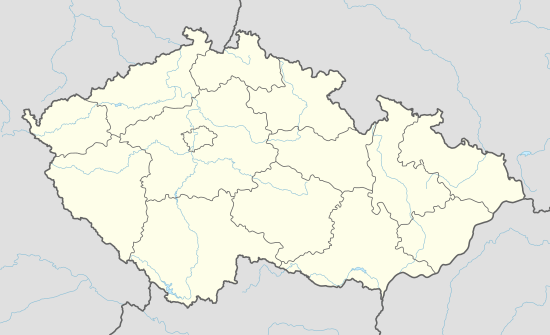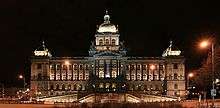National Museum (Prague)
| Národní muzeum | |
.jpg) Main building of the National Museum by day | |
 Location within Prague  Location within Prague | |
| Established | April 15, 1818 |
|---|---|
| Location | Prague, Czech Republic |
| Collection size | 14 million items |
| Website |
www |

The National museum (Czech: Národní muzeum) is a Czech museum institution intended to systematically establish, prepare and publicly exhibit natural scientific and historical collections. It was founded 1818 in Prague by Kašpar Maria Šternberg. Historian František Palacký was also strongly involved.
At present the National Museum houses almost 14 million items from the area of natural history, history, arts, music and librarianship, located in dozens of buildings.
Origins
The founding of the National Museum should be seen in the context of the times, where after the French Revolution, royal and private collections of art, science, and culture were being made available to the public. The beginnings of the museum can be seen as far back as 1796, when the private Society of Patriotic Friends of the Arts was founded by Count Casper Sternberk-Manderschied and a group of other prominent nobles. The avowed purpose of the society was "the renewed promotion of art and taste", and during the time of Joseph II, it would be adamantly opposed to the King. In 1800 the group founded the Academy of Fine Arts, which would train students in progressive forms of art and history.
The National Museum in Prague

The National Museum in Prague was founded on April 15, 1818, with the first president of the Society of the Patriotic Museum being named Count Sternberk, who would serve as the trustee and operator of the museum. Early on, the focus of the museum was on natural sciences, partially because Count Sternberk was a botanist, mineralogist, and eminent phytopaleontologist, but also because of the natural science slant of the times, as perpetrated by Emperor Joseph II of Austria.
The museum was originally located in the Sternberg Palace but it was soon apparent that this was too small to hold the museum's collections. The museum relocated to the Nostitz Palace but this was also found to be of insufficient capacity, which led to the decision to construct a new building for the museum in Wenceslas Square.[1]
The museum did not become interested in the acquisition of historical objects until the 1830s and 40s, when Romanticism became prevalent, and the institution of the museum was increasingly seen as a center for Czech nationalism. Serving as historian and secretary of the National Museum in 1841, Frantisek Palacky would try to balance natural science and history, as he described in his Treatise of 1841. It was a difficult task, however, and it would not be until nearly a century later until the National Museum’s historical treasures equaled its collection of natural science artifacts.
However, the importance of the museum was not in its focus, but rather that it signaled, and indeed helped bring about, an intellectual shift in Prague. The Bohemian nobility had, until this time, been prominent, indeed dominant, both politically and fiscally in scholarly and scientific groups. However, the National Museum was created to serve all the inhabitants of the land, lifting the stranglehold the nobility had had on knowledge. This was further accelerated by the historian Frantisek Palacky, who in 1827 suggested that the museum publish separate journals in German and Czech. Previously, the vast majority of scholarly journals were written in German, but within a few years the German journal had ceased publication, while the Czech journal continued for more than a century.
In 1949, the national government took over the museum, and spelled out its role and leadership in the Museum and Galleries Act of 1959. In May 1964, the Museum was turned into an organization of five professionally autonomous components: the Museum of Natural Science, the Historical Museum, the Naprstek Museum of Asia, African, and American Cultures, the National Museum Library, the Central Office of Museology. A sixth autonomous unit, the Museum of Czech Music, was established in 1976.
Collections and Departments
According to their website, the National Museum at present contains several million items of material in three main parts, the natural Museum, the Historical Museum and the Library.
The Natural Museum
in 2010 moved their collections to Prague 10, Horní Počernice. It has the departments of mineralogy, paleontology, mycology, botany, entomology, zoology and anthropology, as well as scientific laboratories.
The Historical Museum has six departments including Archives
- The Department of Prehistory and Protohistory – Contains an extremely rich collection of artifacts which were used daily thousands of years ago. The curators of this collection were also among the first Czech archeologists: J.L. Píč, curator of one of the collection from 1893-1911 is credited with conducting the first system archeological field exploration in Czechoslovakia. The department also maintains collections in the field of classical archeology, however its main value is in the documentation of Greek and Roman arts and crafts. Among its most valuable objects are a painted dish of Nikosthenes, a glass bottle from the port of Puteolo, and a gilded silver rhyton.archeology which is mostly concerned with the period from Neolithic times to the 10th century CE. The Collection of Classical Archeology belongs to the same department.
- The Department of the Old Czech History has assembled a numerous amount of objects which trace the development of Czech state beginning from the Slavonic culture of 10th century up to the independent republic Czechoslovakia in 1918. This is done through the acquisition of objects which recall outstanding figures of Czech culture and leadership. Collection of Archeology concerns many objects from archaeological excavation of the land (ceramics, metals, stone), artifacts of painting, sculpture and decorative arts beginning from the Roman period through Gothic, Renaissance and Baroque style up to the Romanticism of 19th century.
Important parts of the Medieval collection is jewellery, panel painting, wooden sculpture, and weapons (also such as used in the Hussite movement of the 15th century). In addition to their historical value, many of the objects held by this department contain a high artistic value. Examples of precious objects include: a silver tiara of a duke from the twelfth century; Medieval, Renaissance and Baroque jewelry; liturgical objects from the Medieval period, which include several chalices, the reliquary of St. Eligius in the shape of mitre; Gothic and Renaissance glazed tiles and paving stones; precious embroidery of Rosenberg antependium dated about 1370. Fine Bohemian porcelain and glass collection represent beore all the 18th and 19th centuries, as well as collection of painted portraits and miniature painting.
- The Department of Ethnography – The stated aim of this department is to gather, in a systemic manner, factual material and data about the history and culture of the people of Czechoslovakia and the other nations of Europe, from the end of the 17th century to the present day. It should be noted, however, that much of the focus is placed on Slavic nations. The oldest ethnographic collections of the National Museum were inherited from the Jubilee Exhibition of 1891, with the result being that much of the focus has shifted to the past half-century, and the collections of the department are filled with simple wood and ceramic objects, which show the gradual shift from a rural society to one that has become increasingly urbanized.
- Department of Numismatics – Among the oldest departments in the Museum, it was founded through the gift of Count Sternberk. The goal of this department is to achieve a complete collection of legal tender coins used in past and present day Czechoslovakia. In addition, the department has a great amount of foreign coin collections, the most valuable of these being a collection of coins of classical antiquity. Along with collecting coins, the department also maintains a large collection of medals. At present day, the National Museum contains approximately half-a million objects.
- Archives of the National Museum
It contains the most rare charts and manuscripts of the Czech history from the 11th to the 20th century, the ancient ones have been digitalised. The collection of personal legacy contains written sources of famous personalities of Czech history. Large collection of seals and sealsticks include about 3000 pieces.
- Department of Theater – Originally part of the National Museum Library, it was set up as a separate entity in 1930. Its first collections were primarily drawn from the archives of two theaters: the National Theater and the theater Vinohardy. In the following years, the collections were greatly expanded by the department's founder, Jan Bartos, and his successor, Joseph Knap. The department today contains extensive exhibits on the history of theater in Czechoslovakia, costume designs by prominent Czech artists, music, memorabilia, and items from the Czech puppet theater. The collections primarily contain stagecraft items from the middle of the 19th century to the present day, with efforts being made to enlarge the department’s exhibits from the 18th century.
Main building

The main museum building is located on the upper end of Wenceslas Square and was built by prominent Czech neo-renaissance architect Josef Schulz from 1885 - 1891. Prior to the museum being constructed, there had been several noblemen’s palaces located at this site. With the construction of a permanent building for the museum, a great deal of work which had previously been devoted to ensuring that the collections would remain intact was now put toward collecting new materials.
The building was damaged during World War II in 1945 by a bomb, but the collections were not damaged due to its removal to other secured storage sites. The museum was reopened after intensive repairs in 1947, and in 1960 exterior night floodlighting was installed, which followed a general repair of the facade that had taken place in previous years.
During the 1968 Warsaw Pact intervention the main facade was severely damaged by strong Soviet machine-gun and automatic submachine-gun fire. The shots made numerous holes in sandstone pillars and plaster, destroyed stone statues and reliefs and also caused damage in some of the depositaries. Despite the general facade repair made between 1970 - 1972 the damage still can be seen because the builders used lighter sandstone to repair the bullet holes.
The main Museum building was also damaged during the construction of the Prague Metro in 1972 and 1978. The opening of the North-South Highway in 1978 on two sides of the building resulted in the museum being cut off from city infrastructure. This also led to the building suffering from an excessive noise level, a dangerously high level of dust and constant vibrations from heavy road traffic.
Reconstruction
Due to major renovations the museum will be closed until 2017. Some seven million items had to be removed to the museum’s depositories in what has been dubbed the biggest moving of museum collections in Czech history.[2]
See also
References
External links
| Wikimedia Commons has media related to The National Museum in Prague. |
Bibliography
- Demetz, Peter. Prague in Black and Gold: Scenes from the Life of a European City.New York: Hill and Wang, 1997.
- Denkstein, Vladimir. "From National Museum." In Prague, Great Centers of Art, edited and with introduction by Vladimir Denkstein and Jiri Kotalik. Translated from Czech by Vladimir Varecha. Montclair, N.J.: Allanheld & Schram, 1979.
Coordinates: 50°04′43.79″N 14°25′50.87″E / 50.0788306°N 14.4307972°E